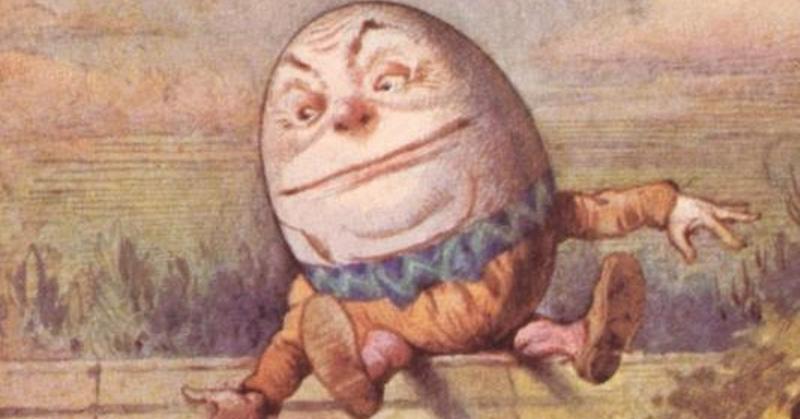Humpty Dumpty Was Code For…
By | October 27, 2022

Humpty Dumpty, the talking egg from the nursery rhyme, is not the simple character he's cracked up to be. For starters, the rotund figure who famously tumbled from a wall was not originally depicted as an egg at all. (We can thank Lewis Carroll, who borrowed the Humpty Dumpty character for his 1871 book Through The Looking-Glass, for that.) The humble verse, in fact, might be coded political commentary.
What Exactly Is A Humpty Dumpty?
In the 1785 Classical Dictionary Of The Vulgar Tongue, the phrase "Humpty Dumpty" is defined as someone who is short, round, and clumsy. Likewise, the Oxford English Dictionary notes that in the 17th century, a "Humpty Dumpty" was an ill-shaped, hapless, overweight person. In this context, the rhyme may refer to a fat boy who clumsily fell from his perch. In the early 1700s, Humpty Dumpty was also the name of an alcoholic drink made of ale boiled with brandy, meaning the nursery rhyme could actually be the tale of a party foul. Most scholars, however, think there's more to it. It's important to note that in earlier versions of the rhyme, the last line read, "Could not make Humpty Dumpty where he was before," which doesn't imply Mr. Dumpty's irreparability, just that he couldn't be hoisted back to the wall for whatever reason.

Was Humpty Dumpty A Political Figure?
Some scholars believe "Humpty Dumpty" was based on Richard III of England. History paints Richard III as a villainous figure with a fearsome appearance, disfigured and hunchbacked, who raped Edward VI's widowed daughter-in-law, had her killed after she became queen, and locked his two young nephews in the Tower of London to prevent them from claiming the throne. Regardless of whether any of this is actually true, it's theorized that "Humpty Dumpty" describes Richard's defeat at Bosworth Field in 1485, having fallen from his horse (called "Wall"), and how his vast armies failed to save him or repair his reign.
Others suggest "Humpty Dumpty" retells the downfall of Cardinal Thomas Wolsey, who was once King Henry VIII's most trusted confidante but sorely disappointed the king by failing to arrange the annulment of his marriage to Catherine of Aragon in 1529. Henry booted the cardinal from government and kicked him out of court, allowing him to stay on as the Archbishop of York but ultimately arresting him for treason. When he died en route to London, he was not buried in the ornate, elaborate tomb that had been prepared for him in Windsor, just as Humpty Dumpty couldn't be buried in his own shell after his great fall.

Was Humpty Dumpty A Weapon?
Military historians point out that Royalists fighting in the English Civil War, which raged from 1642 to 1649, affectionately called the squatty, plump iron cannon in their arsenal "Humpty Dumpty." In June 1648, the Royalists perched the cannon on the stone wall encircling the town of Colchester in an effort to keep the Parliamentarians out, but the invading army responded by attacking the wall, which was so heavily damaged that Humpty Dumpty did indeed have a great fall and couldn't be repaired.
Confusingly, the cannon wasn't the only military tool called "Humpty Dumpty" during the English Civil War. That was also a nickname for siege turtles, a type of rudimentary metal tank-like object that deflected arrows and cannon fire and looked, as the name suggests, like a big turtle shell. Unfortunately, it didn't actually work, so when the Royalists huddled under it to breach the walls of Gloucester, the cannon fire pushed them right off.

